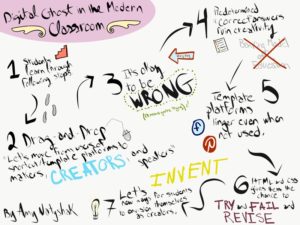Openness in education, technology, differentiation, inclusion, learning, universal learning design: all words that float around the mind of an educator in the 21st century.
For my reflection of the Technologist Module from e-Campus Ontario Open Teacher Modules by Ontario Extend, I decided to do a Twitter essay. This module was created to help teachers integrate technology into their classrooms effectively. As new teacher candidates, this is important and relevant, but I do understand how already experienced teachers could benefit from this module as well. In order to execute my Twitter essay, I created a thread with twenty tweets that summarized the key points of the module while creating connections with my own thoughts and experiences. The process of creating this reflection was actually quite nice; I got to look at some tweets while I took breaks and scroll through tons of funny gifs. I had a lot of fun composing my Twitter essay, and honestly, it’s the most fun I’ve had writing an essay in a long time. I enjoyed trying to find a balance of gifs, polls, images, and plain tweets to create a thread that looked aesthetically pleasing. I wanted to make sure there was a seamless flow to the thread to capture readers’ attention while keeping them engaged throughout the whole Twitter essay. I felt that all of the key points that I wanted to convey was easily done with this platform. I would recommend that others use this platform as well because it is easy to use, allows you to share your thoughts with others easily, and it’s just fun. A lot of fun actually.
As I went through this module, I was surprised as to how much I learned. To be honest, before I began this module, I thought I knew everything about technology integration because of my experience using it in the past. I knew how to navigate a plethora of different websites and could easily give students directions on how to access them. Turns out that there is a lot more to it than just that. There are ways to integrate technology into the classroom that are more innovative than simply using it to show a video. I always thought of the use technology as an element of a lesson instead of the means of addressing certain learning challenges. Technology should be used in a meaningful context in today’s classroom where students will learn, collaborate, and communicate their knowledge with others.
Further, technology has the ability to implement differentiation and Universal Learning Design (UDL) in the classroom. Although this wasn’t explicitly covered in the module, it is absolutely applicable. Using certain websites or applications can apply UDL. A lot of different platforms cover different means of representation which supports different learning preferences. Also, differentiation can occur through technology by simply adapting the work that is being done with it. I have attached a chart below of both teaching strategies so you can consider how you could apply technology with these strategies in mind. Overall, technology is a tool that can integrate important teaching strategies as well.

Source: Overview of UDL/Differentiated Instruction
What this module taught me was the following: technology in the classroom is much more than the use of a video, social media site, or google search; it is challenging students to innovate and create something with the use of technology to solve problems.
This module has influenced my practice because I will design my lesson plans with technology in mind, but I will also design it with the Design Thinking Approach and the SECTIONS model. Creating authentic, meaningful tasks to facilitate learning with technology creates an engaging space for students to learn; however, we must consider the students when designing what and how they will use the technology. Student learning and student safety is of top priority.
While going through my Twitter essay, I hope you find useful resources to access, engage with the polls, and maybe even laugh at a gif or two.
Check out my Twitter essay here:
1. Multimedia Reflection time!
Today's reflection is on the Technologist Module of the e-Campus Ontario Open Teacher Modules. The goal of the module? Using technology as a tool to address specific learning challenges. Let's go! #UWinDig #OntarioExtend https://t.co/yUs5PdbmoI— Amy (@amynatyshak) February 14, 2019
I wish all of my fellow educators good luck in curating meaningful, technology-oriented lessons.
Enjoy!
– Amy

